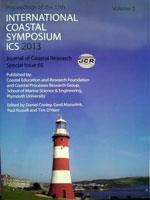Reyes-Merlo, M.Á., Díez-Minguito, M., Ortega-Sánchez, M., Baquerizo A. and Losada, M.Á., 2013. On the relative influence of climate forcing agents on the saline intrusion in a well-mixed estuary: Medium-term Monte Carlo. In: Conley, D.C., Masselink, G., Russell, P.E. and O'Hare, T.J. (eds.), Proceedings 12 International Coastal Symposium (Plymouth, England), Journal of Coastal Research, Special Issue No. 65, pp. 1200–1205, ISSN 0749-0208.-->
In this work we analyze the estuarine circulation and the dependence of the salt intrusion on the climate forcing agents in the Guadalquivir river estuary. The salt flux driving mechanisms are discussed. Exchange flow is identified and characterized by means of estimates of the effective vertical turbulent viscosity Nz, which decreases from 1.2·10−3 m2/s near the mouth to 3.3 · 10−4 m2/s in the middle reach of the estuary due to the decrease of the shear stress and to the longitudinal density gradient. Power-law relationships are obtained to assess the relative influence of the tidal current amplitude, river flow, and wind conditions at the inner shelf on the saline intrusion. It is found that the dependence of the salt intrusion on the river flow increases with the flow, and the gravitational circulation is greatly enhanced during the fluvially-dominated regime. The influence of tides increases after high discharges due to the reduction of the boundary shear stresses associated to the mud entrainment. Easterly winds favors the baroclinic circulation, increasing the injection of saltier water, which replaces the superficial, low-salinity water flushed out of the estuary. The obtained relationships are used to predict on a medium-term basis the effect of different management strategies on the saline intrusion, by means of Markov Chain Monte Carlo simulations. Results show that the mean intrusion length would increase about 8% under the expected scenario in which the freshwater discharges decrease by 15% the next 15 years.





